The Pearl of the Silk Road—Online Exhibition of Kucha Murals
-1024x610.jpg)
前言/Preface
古丝绸之路是东西方文明融合、交流和对话之路,为人类的共同繁荣做出了重要贡献。龟兹位于古丝绸之路新疆段北道要冲,历史上曾经是佛教兴盛之地,佛教石窟众多。龟兹现遗存的石窟共有27处,800余个洞窟,近10000平方米壁画和部分彩绘泥塑,是丝绸之路文化交流美丽而确切的见证。
As a road for cultural integration and exchange between the East and West, the ancient Silk Road has contributed greatly to the common prosperity of mankind. Kucha(Qiuci), located in present day in Xinjiang Uygur Autonomous Region,was an important passage of the ancient Silk Road. The ancient Kucha was one of famous Buddhist centers, where hundreds of grottoes were built. A total of 27 grottoes, over 800 caves and nearly 10,000 square meters of murals and painted clay sculptures are preserved in Kucha, reflecting the harmonious cultural exchanges along the Silk Road.
龟兹的壁画艺术生动记录了古丝绸之路的历史,题材内容丰富多彩,被誉为“故事的海洋”。据统计,龟兹壁画中所描绘的佛本生故事和因缘故事有100余种,佛传故事60多种,数量之多、画面之丰,在世界石窟艺术中亦属罕见。描绘在中心柱窟券顶上的菱格画堪称龟兹壁画的独创经典。本展览以龟兹壁画艺术为主要内容,打造菱格主题虚拟展厅,通过“大漠遗迹”、“壮美河山”、“人性华光”、“薪火相传”四个篇章向观众展示东西交流、文化碰撞的丝路遗珠。通过展示壁画中真诚与信义、自我牺牲追求至善,以及智慧与美德的故事,展现龟兹壁画艺术中对“真、善、美”的追求。
As part of the historical record of the ancient Silk Road, Kucha murals are known as “seas of stories” for their wonderful and abundant content. More than 100 Jataka tales and Nidana tales and 60 Buddhist stories have been found in Kucha. The grotto art site, with its abundant murals of great variety, is something rarely found anywhere in the world. Rhombic paintings at the roof of the grotto are a unique feature of Kucha murals. The exhibition will demonstrate the murals of Kucha, the pearl of the Silk Road, in four units, namely “Desert Relics”, “Magnificent Landscape”, “Glory of Humanity” and “Cultural Continuity”. The multicultural integration and collision will be displayed in a rhombic-themed online exhibition hall. The pursuit of truth, kindness and beauty of Kucha mural art will be displayed by stories of earnestness, sincerity, sacrifice, wisdom and virtue.
文明因交流而多彩,因互鉴而发展。两千多年的交流促进了不同种族、信仰、文化背景的国家共享和平、共同发展。如今,共商、共建、共享丝绸之路经济带和21世纪海上丝绸之路,更需要将丝绸之路所承载的和平合作、开放包容、互学互鉴、互利共赢精神薪火相传,在文明交流史上续写灿烂篇章。
Diversified cultures grow from exchanges and the richness of art comes with mutual learning and understanding. With more than 2,000 years of exchanges, the peaceful and common development of countries with different races, religions and cultural backgrounds has been flourishing. At present, we should inherit the spiritual heritage of peace and cooperation, openness and inclusiveness, mutual learning and mutual benefit in implementation of the Silk Road Economic Belt and the 21st-Century Maritime Silk Road under the principles of extensive consultation, joint contribution and shared benefits to achieve brilliant exchanges and communication in modern times.
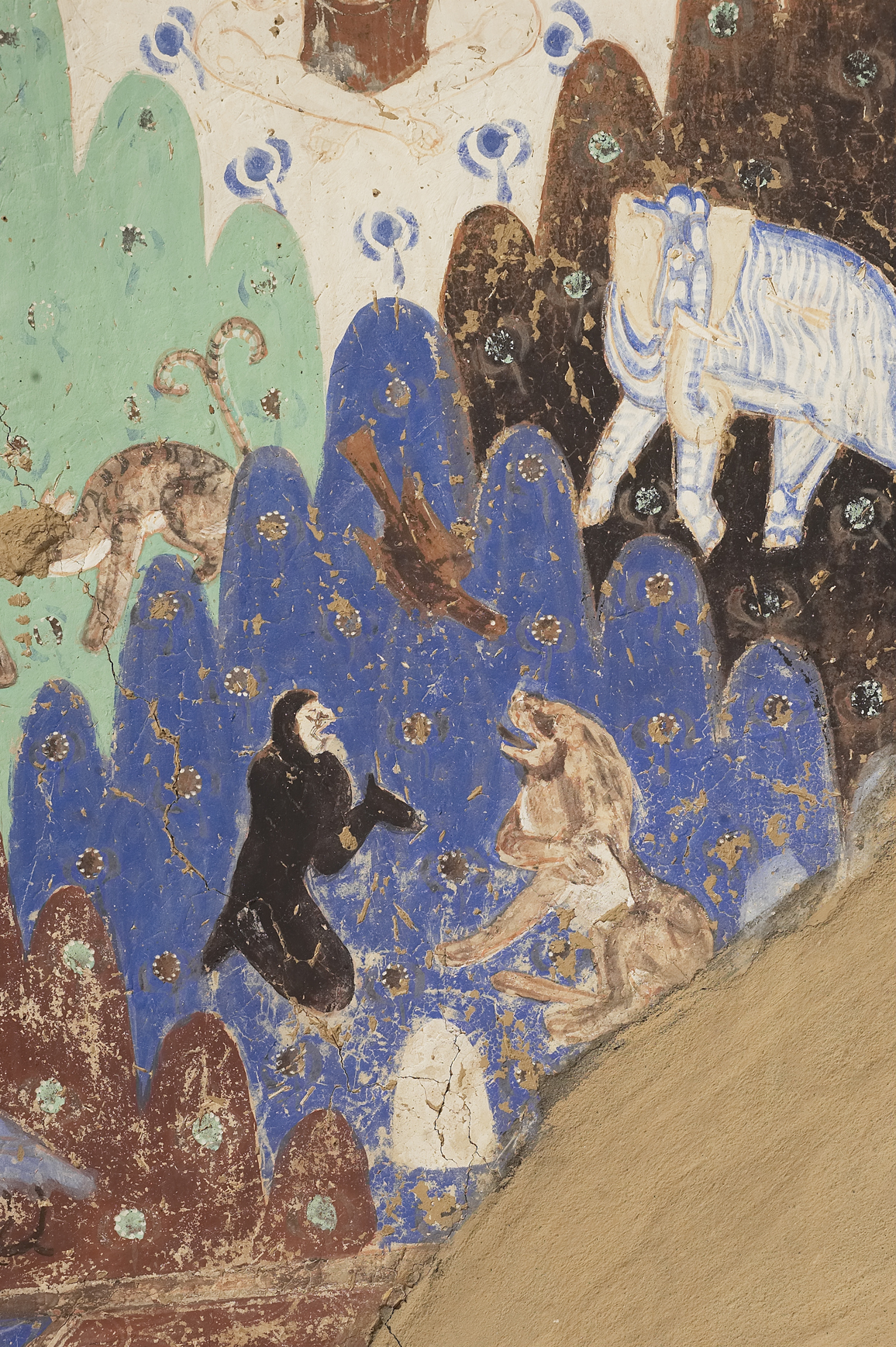
《狮王舍身不失信》克孜尔石窟第14窟
Lion King Sacrifices Himself for Living Up to His Words
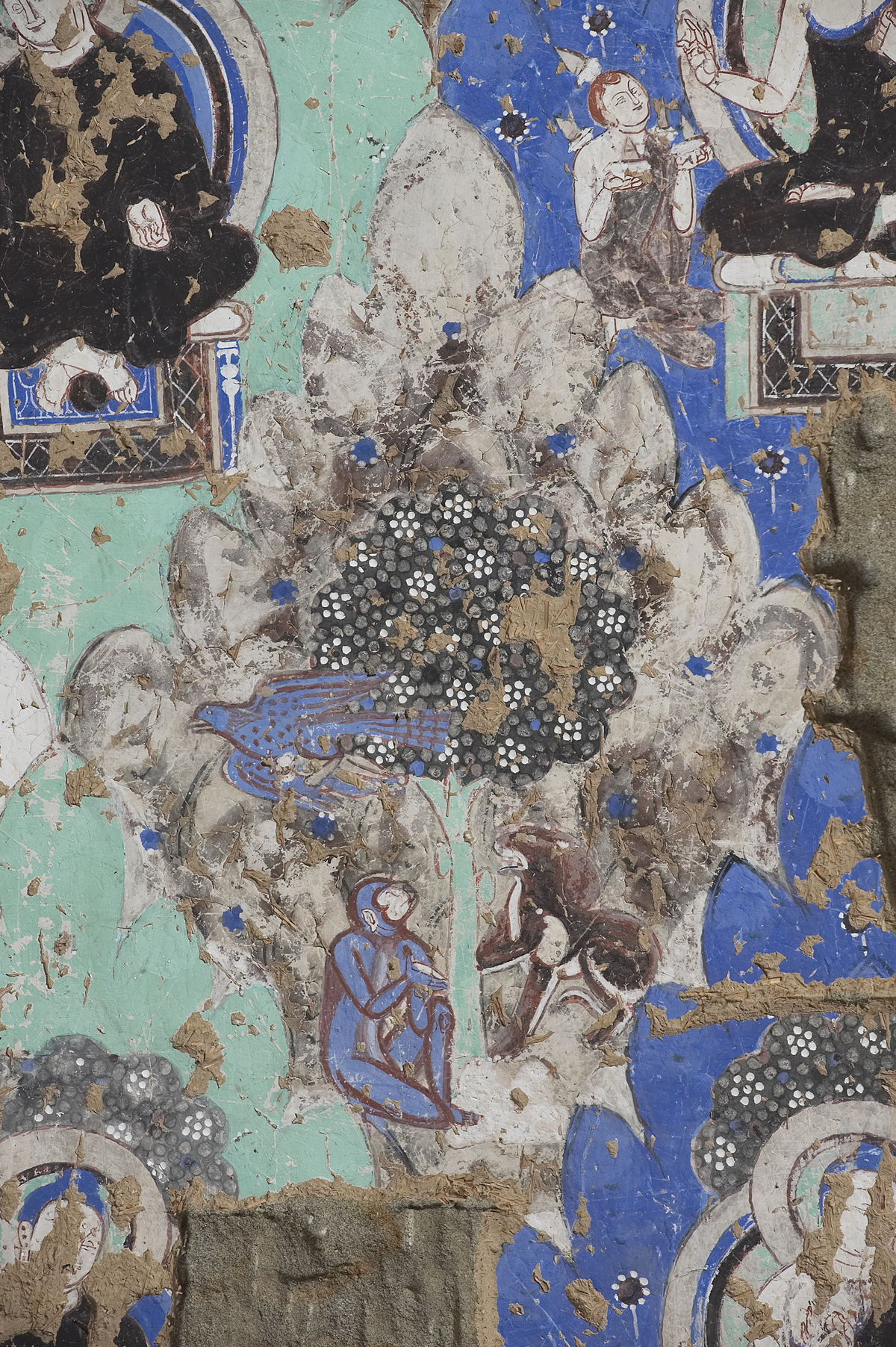
《狮王舍身不失信》克孜尔石窟第38窟
Lion King Sacrifices Himself for Living Up to His WordsKizil Grottoes (No. 38)
One day, a macaque went out for food and asked the lion king to look after her babies. Unfortunately, the two baby macaques were captured away by a hungry vulture when the lion king was dozing. To live up to his words, the king lion found the vulture and begged him to free the two babies. In the end, the lion exchanged his flesh for the safety of two baby macaques.
一天猕猴外出觅食,把孩子托付给狮王看护。狮王打瞌睡时,两只小猕猴被饥饿的秃鹫当作猎物叼走了。为了保守与猕猴的诺言不失信,狮王找到秃鹫并哀求。最终用自己身上的肉换回了两只小猕猴。
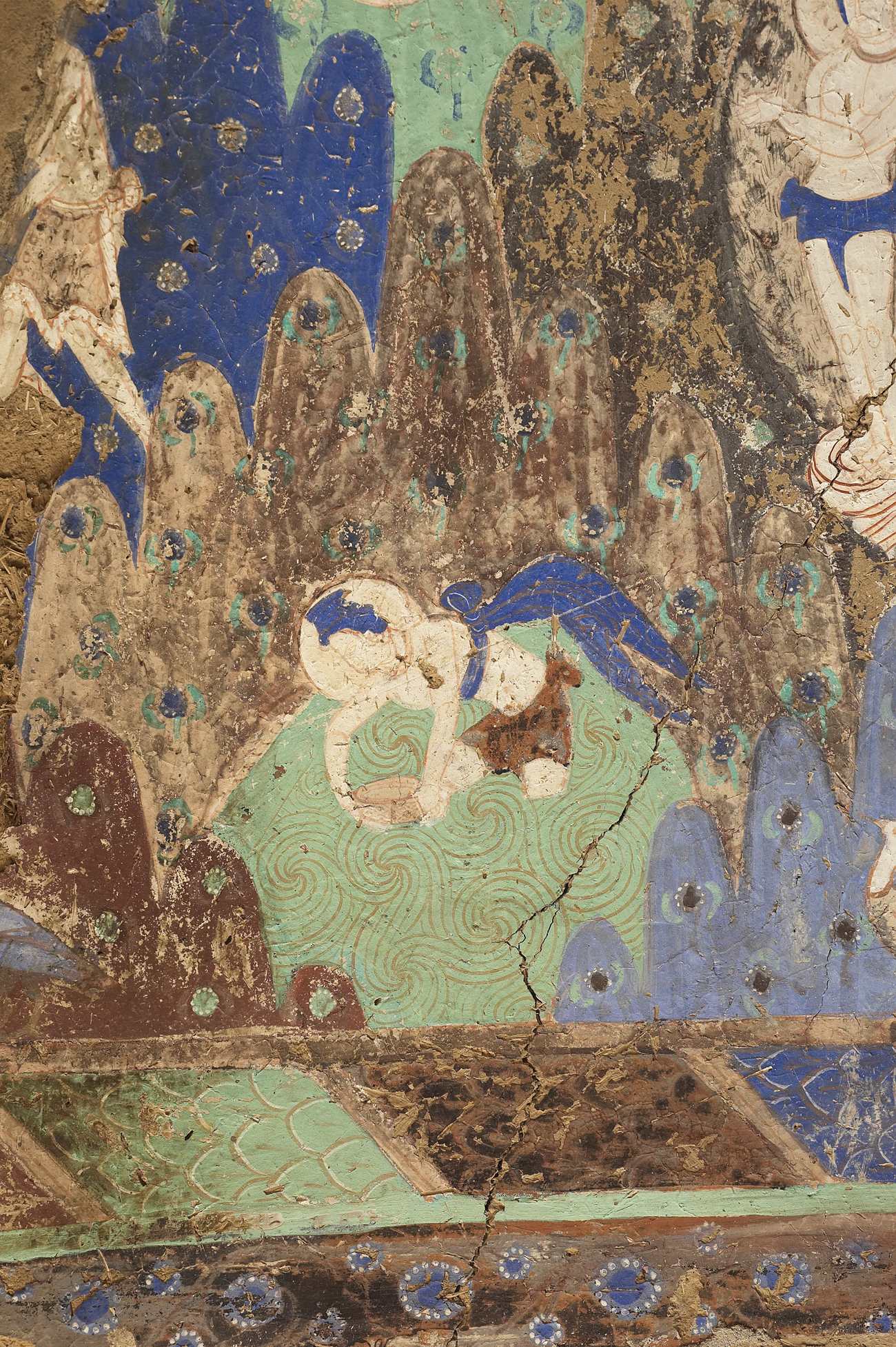
《大施抒海夺珠》,克孜尔石窟第14窟
Dashi Ladles out the Sea Water to Regain the PearlsKizil Grottoes (No. 14)

《设头罗健宁王舍身为鱼施饥民》,克孜尔石窟第17窟
King Shetouluo Jianning Turns into a Big Fish for People to EatKizil Grottoes (No. 17)

《设头罗健宁王舍身为鱼施饥民》,克孜尔石窟第114窟
King Shetouluo Jianning Turns into a Big Fish for People to EatKizil Grottoes (No. 114)
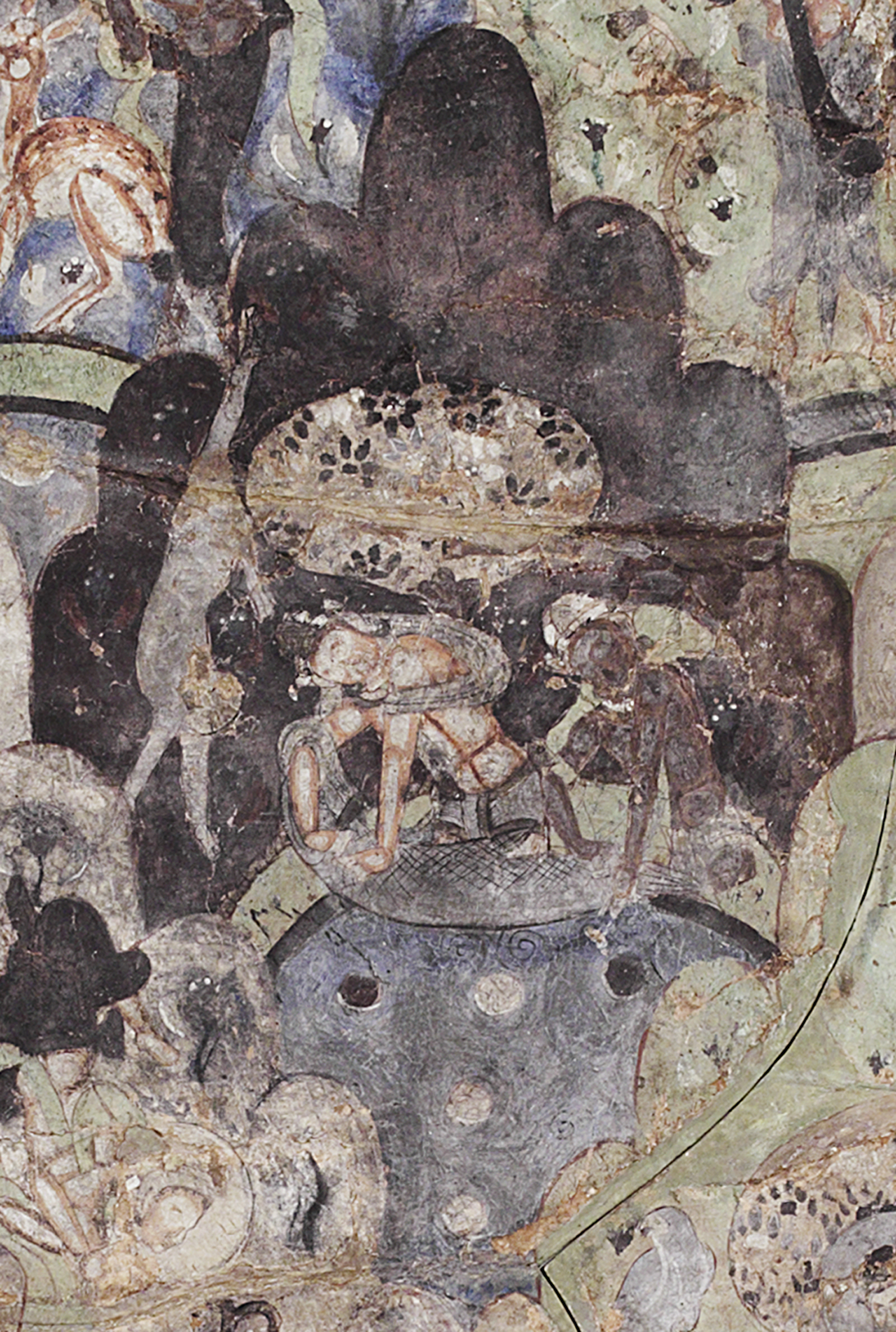
《设头罗健宁王舍身为鱼施饥民》,克孜尔石窟第178窟
King Shetouluo Jianning Turns into a Big Fish for People to EatKizil Grottoes (No. 178)
一年大旱,设头罗健宁王将国库的粮食全部拿出来赈灾,但依然不够,死亡人数不断增加。于是国王发誓愿化作大鱼,救济百姓,说完便投河变成一条大鱼。百姓们砍食鱼肉,鱼的一边被吃光后便自动翻身,整个鱼身都被吃完后又会变出一条完整的大鱼。如此反复变换,满足了国中所有百姓的需要,度过了粮荒。
In a year of drought, King Shetouluo Jianning took out all the food from the national treasury for disaster relief. However, it was still insufficient, and the death toll continued to increase. Seeing this, the king swore to turn into a big fish to save his people. Then he dove into the river and turned into a big fish. Later, the fish was pigged out by people. Surprisingly, it turned over by itself when people ate up one side, and became another complete fish once people ate it up. Finally, all the people had enough food and survived in the year of famine.

《猕猴王舍身救群猴》,克孜尔石窟第17窟
Macaque King Sacrifices Himself for Saving His Fellow MonkeysKizil Grottoes (No. 17)
猕猴王与众小猕猴一起生活。一年大旱,众猴们去国王的花园偷果充饥被发现,逃跑时计划用藤条攀爬过河,但藤条太短,猕猴王只能用自己的身体作桥助众猴过河,后因力尽落水,众猴被捕。猴王请愿牺牲自己一人供君臣饱餐。国王大受触动,下令此后禁止捕猴。
Once, the macaque king was living with many little macaques. In a year of drought, the macaques were suffering from hunger. They went to steal fruits from the king’s garden but were found. When escaping, they planned to cross the river by using a cane but the cane was too short. The macaque king had to use his body to bridge the gap and help his fellows cross the river. It was too hard for the macaque king to help all macaques cross the river. Finally, the macaque king fell into the river because of exhaustion and all his fellows were captured. The macaque king petitioned to sacrifice himself to feed the king and his ministers, provided his fellows could be freed. The king was so moved that he banned macaque hunting from then on.
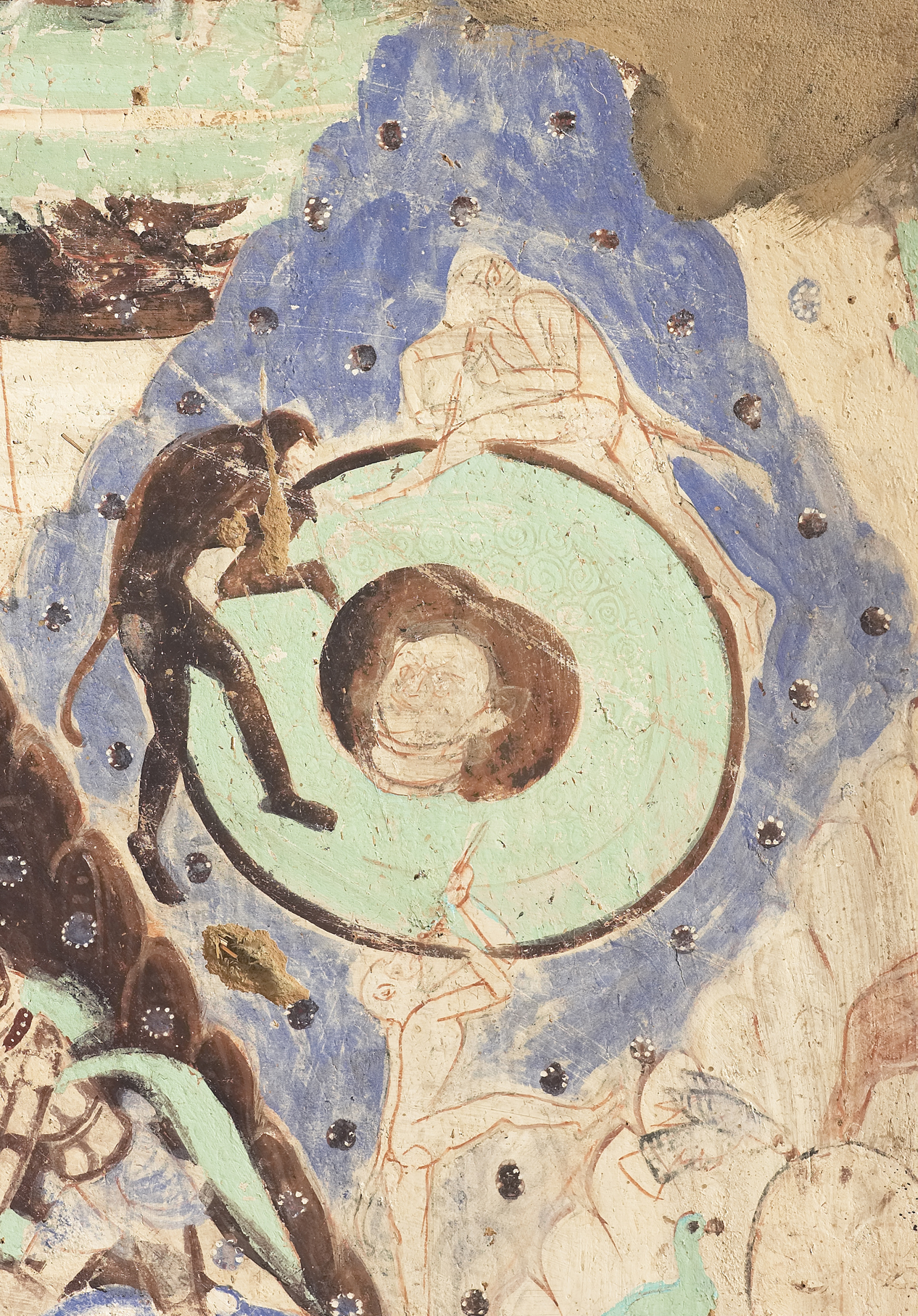
《猴王智斗水妖》,克孜尔石窟第17窟
Monkey King Tricked Water Demon with WisdomKizil Grottoes (No. 17)
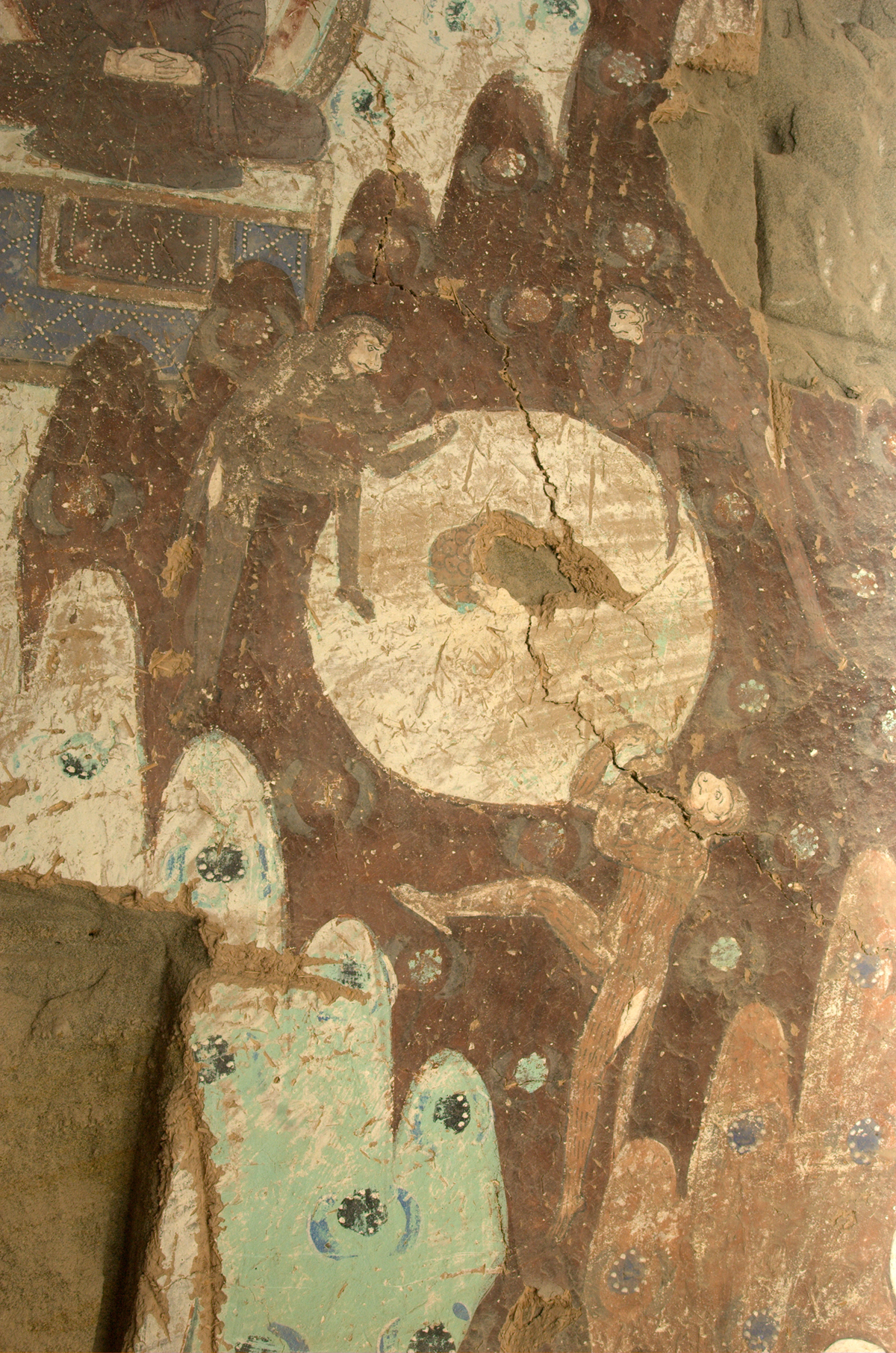
《猴王智斗水妖》,克孜尔石窟第206窟
Monkey King Tricked Water Demon with WisdomKizil Grottoes (No. 206)
森林的莲花池里住着水妖,专吃进入池子里的动物。猴王带领猴群下山喝水,为了众猴们既能喝水又不被水妖吃掉,猴王急中生智让小猴们找来芦苇杆,做成长长的吸管插入池中吸水喝,小猴们喝饱水开心的回家了。
Once upon a time, there lived a water demon in the lotus pond of the forest, who ate everything that came into the pond. The monkey king led his fellow monkeys down the mountain to look for water. To help his fellows drink water while not being eaten by the water demon, the monkey king came up with a solution at the spur of the moment. He asked little monkeys to find reed rods to make a long straw and inserted it into the pond to drink water. The little monkeys went home happily after drinking enough water.
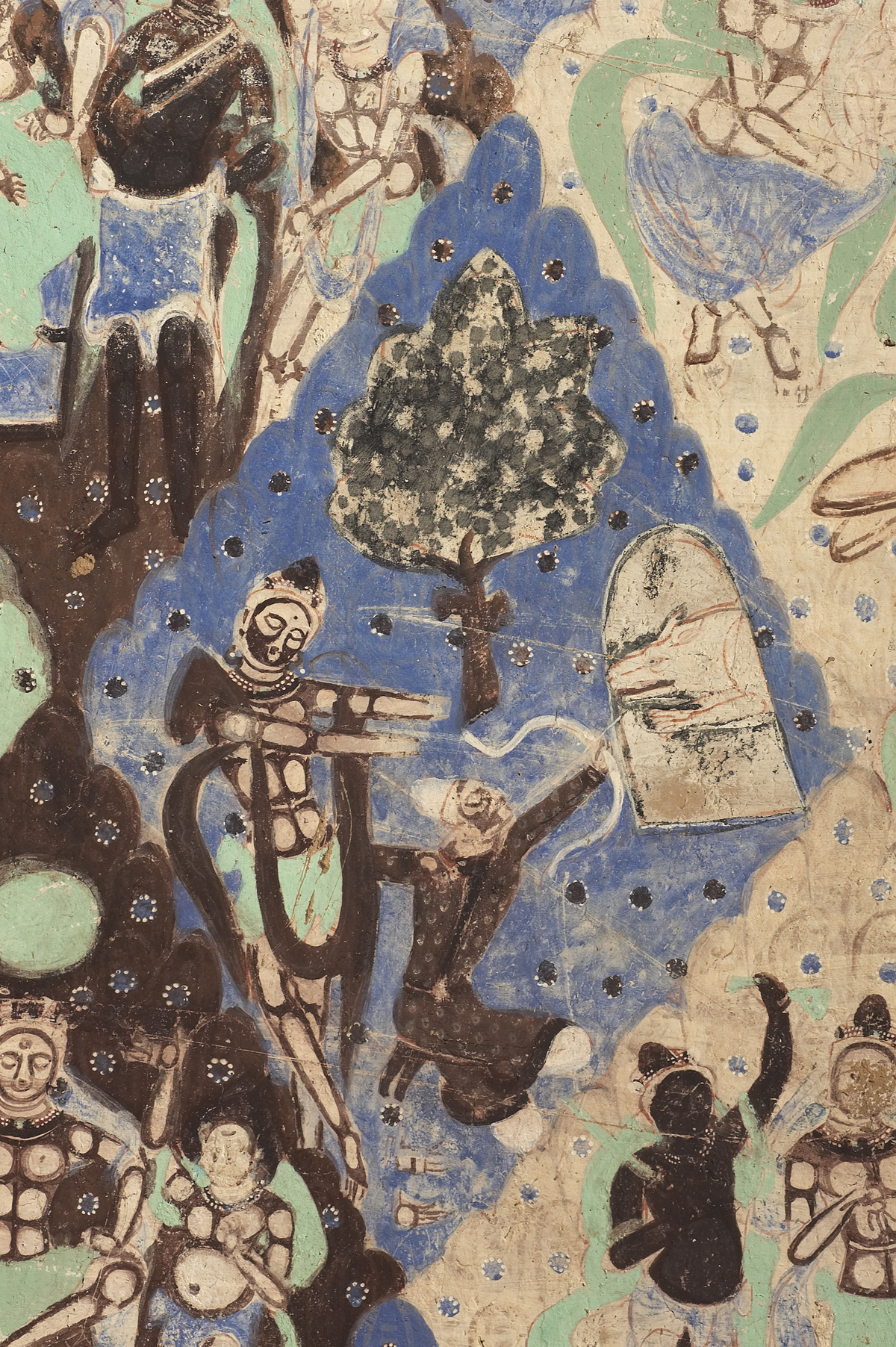
《樵夫背恩》,克孜尔石窟第17窟
Woodcutter Violates His Own CommitmentsKizil Grottoes (No. 17)
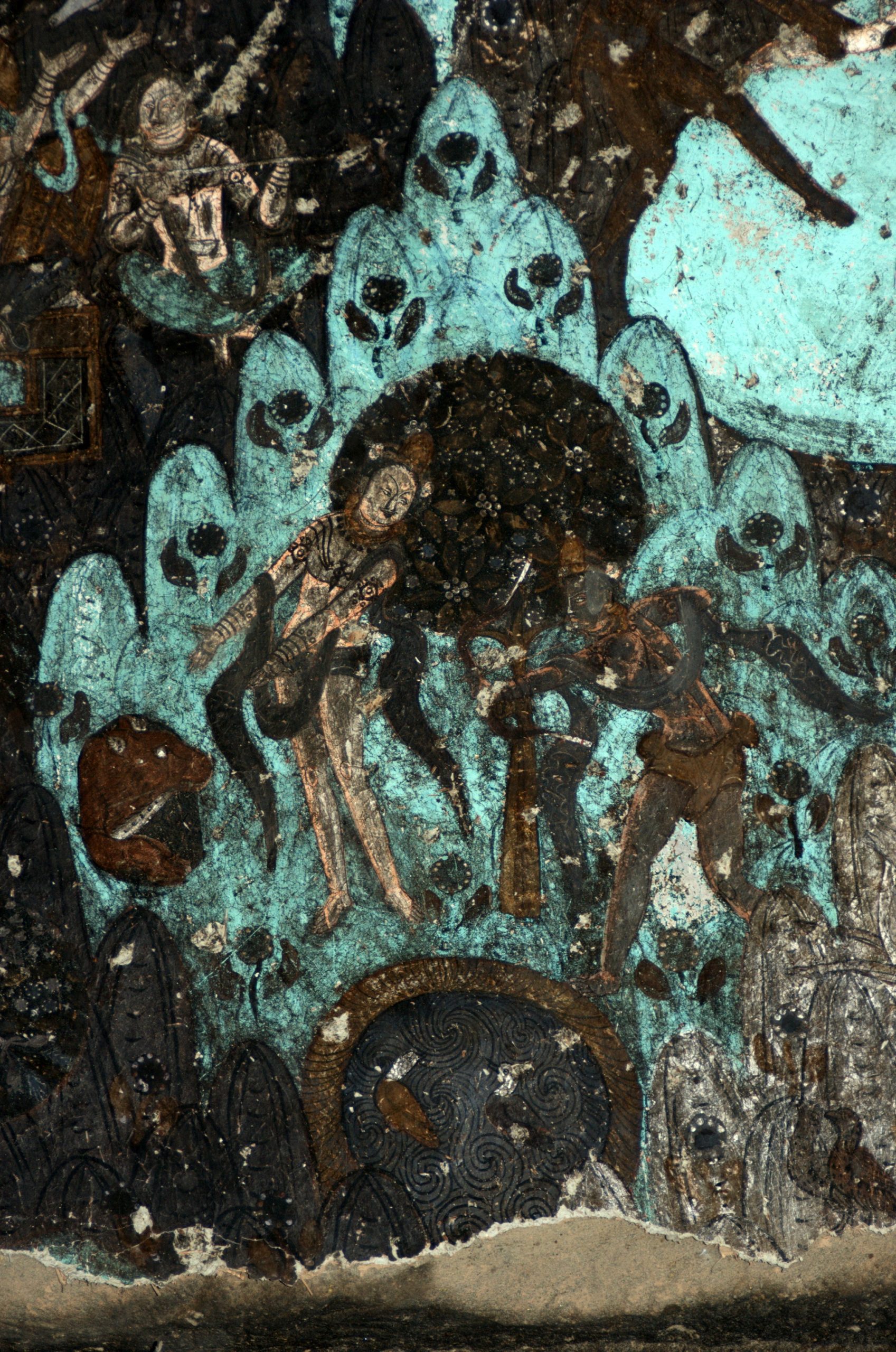
《樵夫背恩》,克孜尔石窟第114窟
Woodcutter Violates His Own CommitmentsKizil Grottoes (No. 114)

《樵夫背恩》,库木吐喇石窟第63窟
Woodcutter Violates His Own CommitmentsKumtura Grottoes (No. 63)
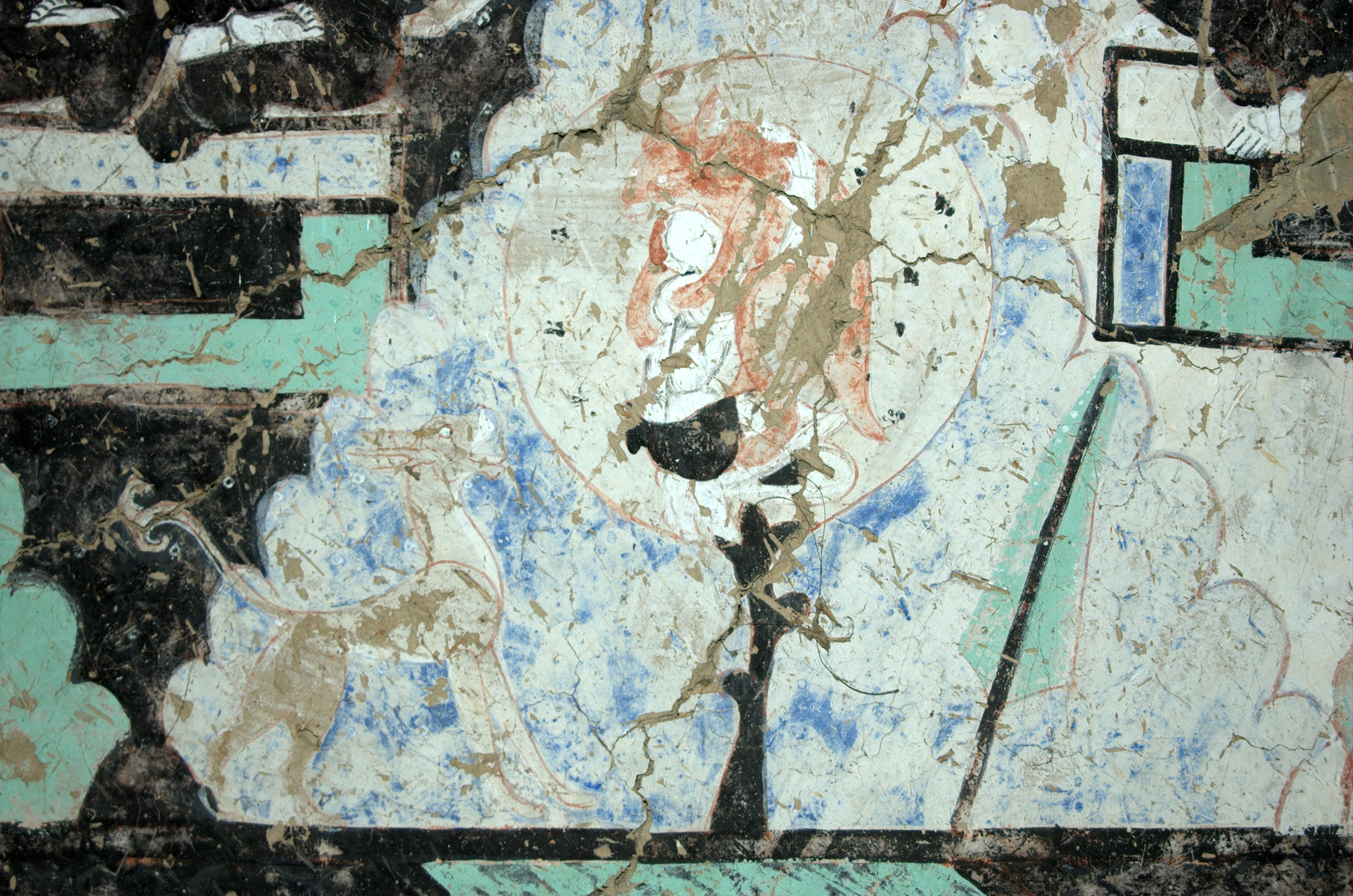
《樵夫背恩》,克孜尔石窟第63窟熊救樵人被虎食
Bear is Ate by Tiger for Saving Woodcutter Kizil Grottoes (No. 63)
有个樵夫路遇暴雨到山洞中躲避,洞中的熊收留了他。暴雨停后,樵夫跪谢熊恩保证绝不透露熊的住所。返城途中樵夫碰到猎人,经不住利益诱惑,起了贪婪之心出卖了熊。猎人射杀了熊,把肉分给樵夫时,樵夫接肉的双手立即断落在地。由于背信弃义,樵夫得到了应有的报应。
A woodcutter took refuge in a cave during a storm, where a bear took him in. When the storm stopped, the woodcutter knelt down to thank the bear and promised not to disclose its residence. On his way back, the woodcutter met a hunter and ate his words for profits. The hunter killed the bear. When he shared the bear meat with the woodcutter, the woodcutter’s hands were immediately broken and fell to the ground. The woodcutter got his comeuppance for his treachery.

《须陀素弥王诚而有信》,克孜尔石窟第17窟
Sutasoma is in Good FaithKizil Grottoes (No. 17)

《须陀素弥王诚而有信》,克孜尔石窟第38窟
Srutasoma is in Good FaithKizil Grottoes (No. 38)
阎浮提有个跛足王,以人肉为食,决定用一千个小国国王的头颅来宴请众罗刹。他抓到了九百九十九个。直到抓到须陀素弥王。须陀素弥王请求跛足王给他七天时间,完成他承诺给行乞婆罗门的布施,跛足王答应了。须陀素弥王完成布施后如期返回山中感化了跛足王,使他释放了所有人。
There was a lame king in Jambudvipa, who fed on human flesh. He decided to fete demons with 1,000 heads from kings of small states. He caught 999 kings before Srutasoma was captured. Srutasoma begged for seven days to fulfill his promise to give alms to mendicant Brahmin, and the king agreed. Srutasoma came back as scheduled after fulfilling his promise., In the end, under the influence and persuasion of Srutasoma, the king set all people under arrest free.

《兔焚身施仙人》,克孜尔石窟第14窟
Hare Burns Itself for the Deity to EatKizil Grottoes (No. 14)

《兔焚身施仙人》,库木吐喇第63窟
Hare Burns Itself for the Deity to EatKumtura Grottoes (No. 63)
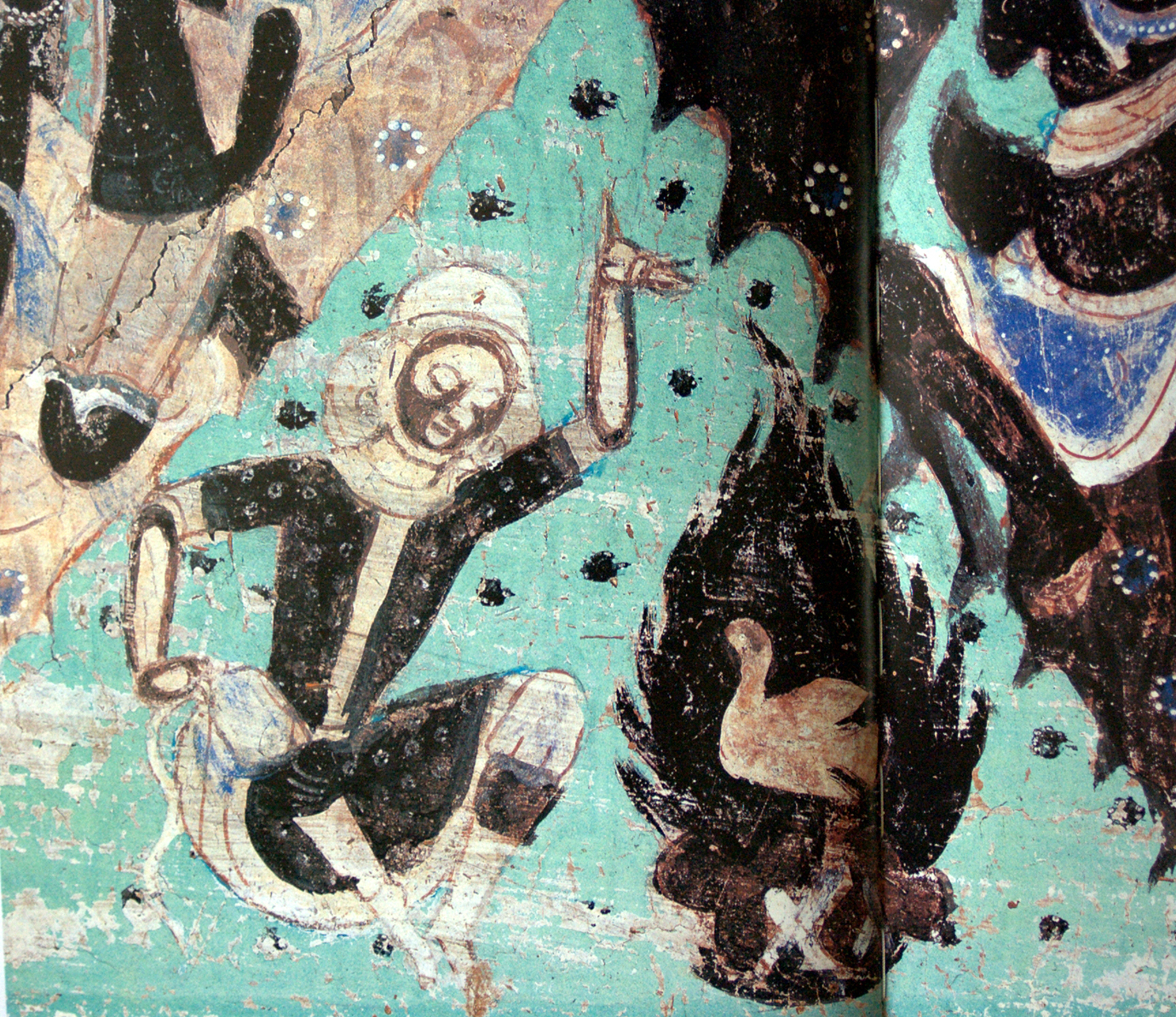
《鸽焚身施迷路人》,克孜尔石窟第17窟
Pigeon Burns Itself for the Deity to EatKizil Grottoes (No. 17)
1.山中有一仙人修习佛法,他与一只野兔相处亲密无间。大旱之年山里没有食物,仙人欲中断修行下山找食物,野兔不忍,找来木柴自己跳入烈火,烤熟供仙人食用。天神也被感动,降下雨水,山里瓜果树木都恢复了生机。
1. Once upon a time, there was a deity in the mountain who practiced Buddhism. He got along well with a hare. In a year of drought, there was no food in the mountain, so the deity decided to stop his practice to find food downhill. The hare was unwilling to see that.- In the end, the hare collected wood and jumped into the fire to burn itself for the deity to eat. The God was moved by the hare and brought the mountain rain. Finally, all plants in the mountain were revitalized.
2、雪山生活着一只鸽子。一天,它见到一队人因暴风雪迷失了方向,饥寒交迫,生命危在旦夕。鸽子怜悯行人,衔来柴草点燃供迷路人取暖,又毅然跳进烈火之中,把自己烤熟让迷路人充饥。迷路人接受了鸽子的施舍恢复了体力走出大山。
2. Once upon a time, there was a pigeon living in the snow mountain. One day, a group of people lost their way in the snowstorm and suffered from hunger and cold, on the verge of death. Seeing that, the pigeon took firewood and lit it to help them keep warm, and then resolutely jumped into the fire to burn itself for them to eat. Thanks to the pigeon, those people restored strength and walked out of the mountain.

《大施抒海夺珠》,克孜尔石窟第17窟
Dashi Ladles out the Sea Water to Regain the PearlsKizil Grottoes (No. 17)
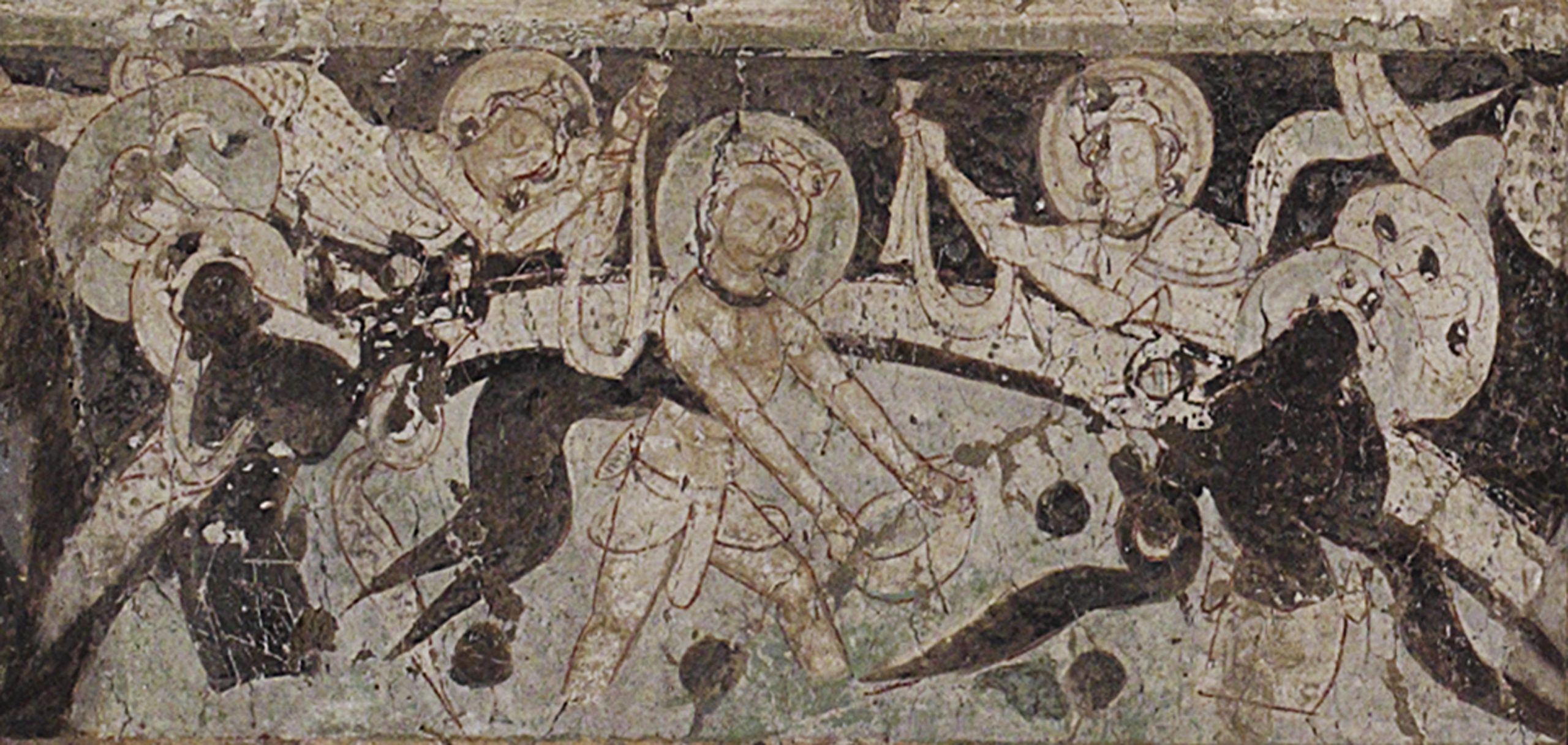
《大施抒海夺珠》,克孜尔石窟第186窟
Dashi Ladles out the Sea Water to Regain the PearlsKizil Grottoes (No. 186)
阎浮提有个人叫大施,经过千难万险从龙宫得到三颗宝珠准备帮助穷人,龙王后悔收回了宝珠。大施发誓要将海水舀空夺回宝珠。天神感动于大施不惧艰难,为民夺珠的决心,帮助退海一百二十里。龙王见此赶紧把宝珠还给了大施,大施带着宝珠回到阎浮提帮助了穷人。
There was a man called Dashi in Jambudvipa. He got three pearls from the Dragon Palace after overcoming untold hardships, in the hope of helping the poor. However, the Dragon King went back on his words and took them back. Dashi swore to ladle out the seawater to regain the pearls. The God, who was moved by his determination, made the sea regress for 120 li. Seeing this, the Dragon King hastily returned the pearls to Dashi. Finally, Dashi returned to Jambudvipa with the pearls to help the poor.

《猕猴王舍身救群猴》,克孜尔石窟第38窟
Macaque King Sacrifices Himself for Saving His Fellow Monkeys Kizil Grottoes (No. 38)
猕猴王与众小猕猴一起生活。一年大旱,众猴们去国王的花园偷果充饥被发现,逃跑时计划用藤条攀爬过河,但藤条太短,猕猴王只能用自己的身体作桥助众猴过河,后因力尽落水,众猴被捕。猴王请愿牺牲自己一人供君臣饱餐。国王大受触动,下令此后禁止捕猴。
Once, the macaque king was living with many little macaques. In a year of drought, the macaques were suffering from hunger. They went to steal fruits from the king’s garden but were found. When escaping, they planned to cross the river by using a cane but the cane was too short. The macaque king had to use his body to bridge the gap and help his fellows cross the river. It was too hard for the macaque king to help all macaques cross the river. Finally, the macaque king fell into the river because of exhaustion and all his fellows were captured. The macaque king petitioned to sacrifice himself to feed the king and his ministers, provided his fellows could be freed. The king was so moved that he banned macaque hunting from then on.
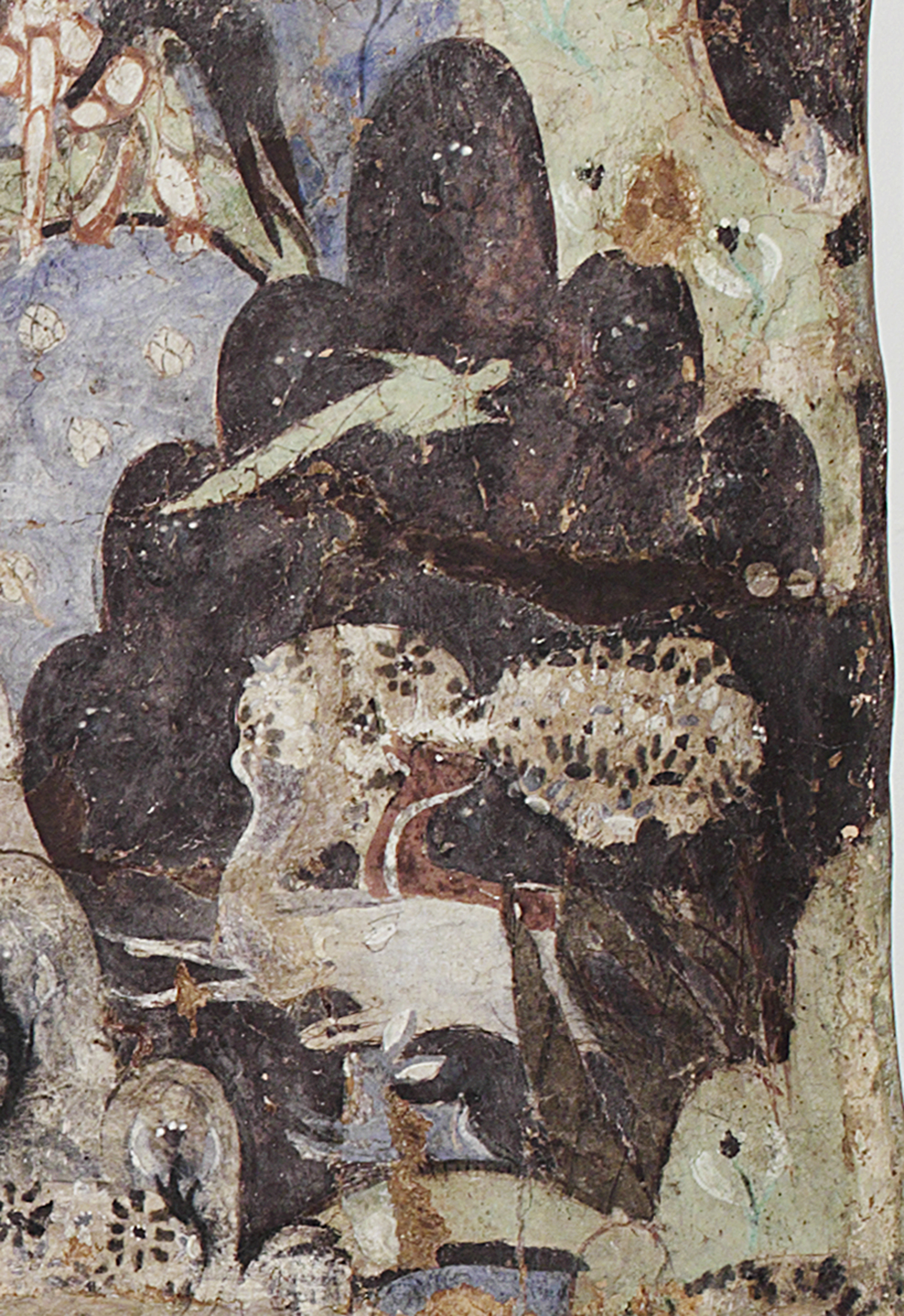
《鹦鹉舍身灭火》,克孜尔石窟第178窟
Parrot Sacrifices Itself for Putting Out FireKizil Grottoes (No. 178)
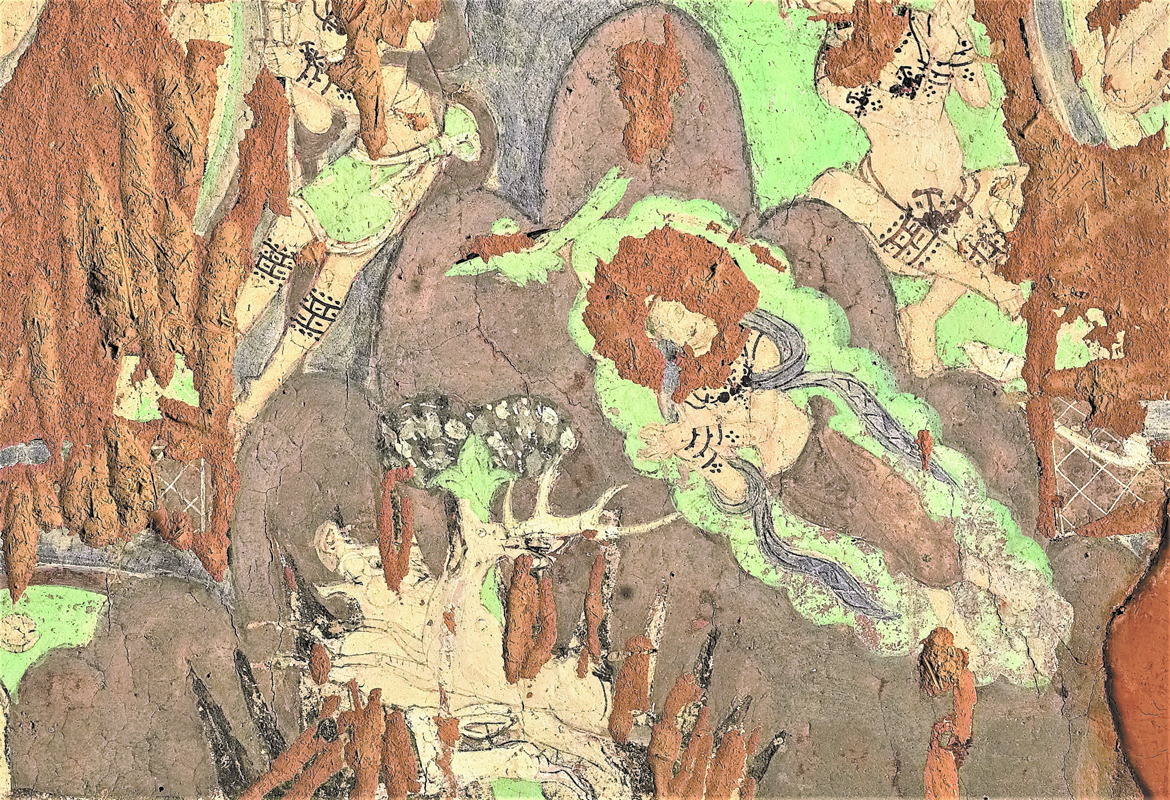
《鹦鹉舍身灭火》,森木塞姆石窟第30窟
Parrot Sacrifices Itself for Putting Out FireSimsim Grottoes (No. 30)
雪山上的竹林里发生大火。所有动物都纷纷逃离,只有一只鹦鹉用翅膀沾水去灭火。帝释天感动于鹦鹉的行动和它的决心,降下大雨扑灭了大火。
A fire struck a bamboo forest on the snowy mountain. When all the animals ran away, only a parrot dipped its wings to put out the fire. Moved by its action and determination, Śakra offered a heavy rain to extinguish the fire.
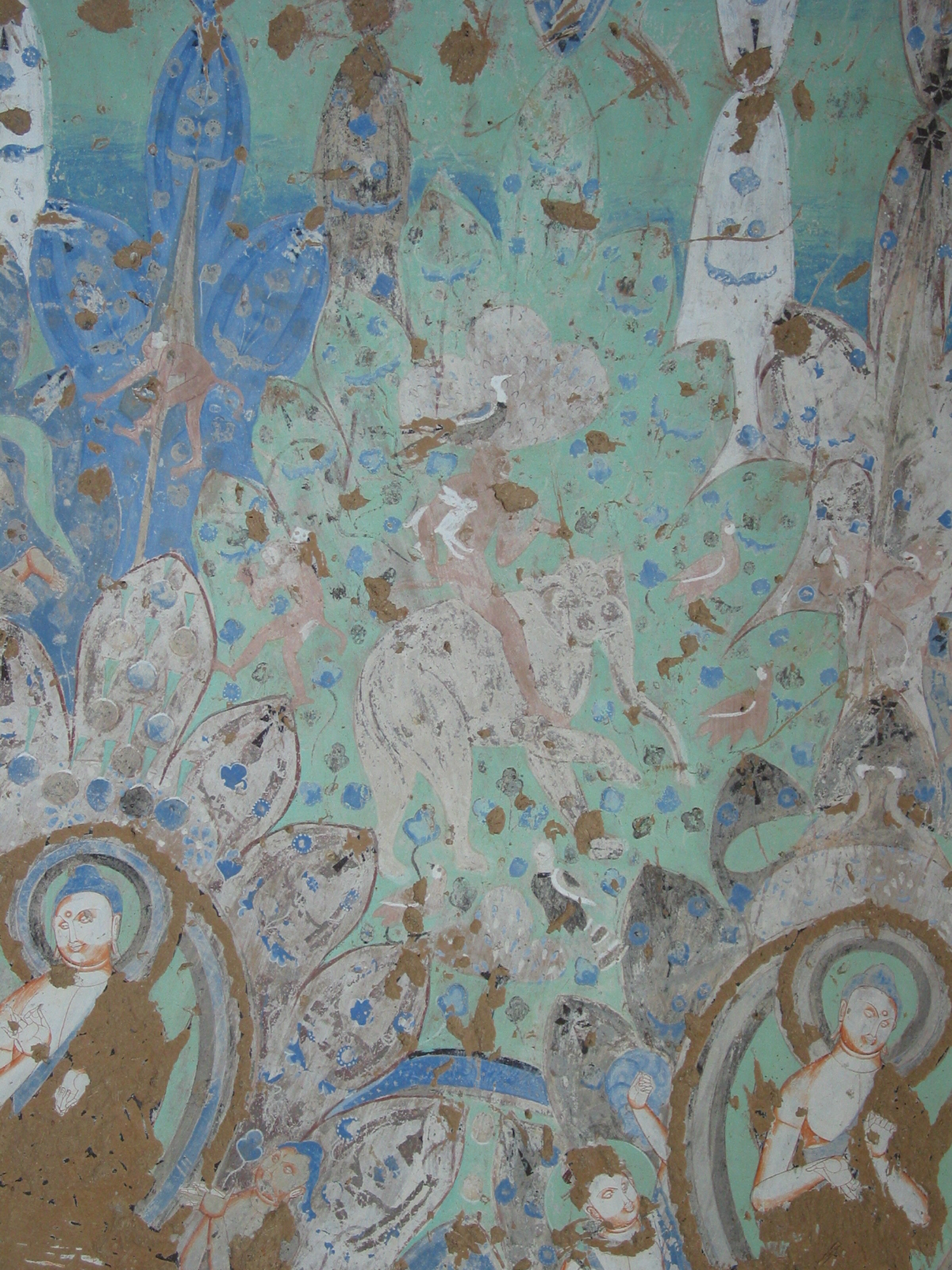
《象、猕猴、鵽鸟自分长幼》,库木吐喇石窟第63窟
Elephant, Macaque, and Turtle Dove Line Up in Order of AgeKumtura Grottoes (No. 63)
象、猕猴、鵽鸟同生活在一颗大树旁边。他们通过交流得知鵽鸟年龄最长,猕猴次之,象最年轻,于是自分长幼、长幼相敬。从此以后,象着驮猕猴,猕猴顶着鵽鸟,开心的生活在一起。
Once, an elephant, a macaque and a turtle dove lived besides a big tree. Through communication, they learned that the turtle dove was the oldest, followed by the macaque and elephant. So they lined up in the order of age and respected and cared for each other. From then on, the elephant carried the macaque and the macaque held the turtle dove, living happily together.

《库木吐喇石窟十三身菩萨像全图》,库木吐喇石窟新2窟十三身菩萨像
Bodhisattva with Thirteen Incarnations, Kumtura Grottoes (digital HD reproduction)
原图绘于库木土喇新2窟,窟顶中心大莲花辐射出十三个梯形条幅,每幅绘一身菩萨。十三身菩萨形态各异,服饰多变,足踏莲花座,头戴珠冠,身披璎珞、臂钏等饰物,上身袒露,下着裙裤,姿态婉约。画面以细致的朱红色线条勾勒轮廓,再敷以淡墨渲染,色彩艳丽,线条流畅,绘制精细,为库木土喇壁画之佳品。
The original mural is in the Kumtura Grottoes New Cave No.2. Thirteen trapezoidal banners are radiated from the lotus flower in the center at the ceiling, with an incarnation of the Bodhisattva on each banner. The thirteen incarnations of the Bodhisattva, in different gestures and costumes, stand on the lotus throne. These incarnations with graceful postures leave their upper bodies uncovered and wear pantskirts, with beaded crowns on their heads and accessories such as jade necklaces and armlets. As a great and delicate mural in the Kumtura Grottoes, it is outlined with fine vermilion lines and rendered with light ink, showing bright colors and beautiful lines.

《说法图》,克孜尔石窟第80窟,约公元7世纪,高155厘米,宽285厘米,袁廷鹤 临摹
Preaching Buddhism )Kumtura Grottoes (No.80) Around the 10th century155 cm high and 285 cm wideCopied work by Yuan Tinghe
袁廷鹤,男,1937年出生,四川人。1990年就职于新疆克孜尔石窟研究所,1998年退休,国家一级美术师。
Yuan Tinghe, male, born in 1937, a native of Sichuan. He is a national first-level artist who worked at Kizil Grottoes Research Institute in Xinjiang since 1990 and retired in 1998.

《菱格塔中坐佛》,库木吐喇石窟第58窟,约公元7世纪,高195厘米,宽199厘米 徐永明 临摹
Sitting Buddha in the Lingge Tower
Kumtura Grottoes (No.58)
Around the 7th century
195 cm high and 199 cm wide Copied work by Xu Yongming (1990)
徐永明,男,1962年出生,湖北人。1986年至今就职于新疆克孜尔石窟研究所,担任新疆克孜尔石窟研究所所长,文博副研究馆员。
Xu Yongming, male, born in 1962, a native of Hubei. He has worked at Kizil Grottoes Research Institute in Xinjiang since 1986. He serves as the director and associate researcher in museology of Kizil Grottoes Research Institute.
,克孜尔石窟第27窟,约公元7世纪,高182.3厘米,宽142.2厘米-张爱红-临摹-scaled.jpg)
《天宫伎乐》,克孜尔石窟第27窟,约公元7世纪,高182.3厘米,宽142.2厘米 张爱红 临摹
Musical Performances in the Heavenly Palace Kizil Grottoes (No.27) Around the 7th century
182.3 cm high and 142.2cmwideCopied work by Zhang Aihong (1993)
张爱红,女,1961年出生,新疆人。1985年——2001年就职于新疆克孜尔石窟研究所,2001年9月调入新疆艺术学院美术学院,副教授,2014年6月退休。
Zhang Aihong, female, born in 1961, a native of Xinjiang. She worked at Kizil Grottoes Research Institute in Xinjiang from 1985 to 2001. In September 2001, she was transferred to the Fine Arts School of Xinjiang Arts University, worked as an associate professor and retired in June 2014.

《龟兹供养人》,克孜尔尕哈石窟第14窟, 约公元6世纪,高114.5厘米,宽170.5厘米 郭峰 临摹
Kucha DonorKizilgaha Grottoes (No.14)
Around the 6th century
114.5 cm high and 170.5 cm wide
Copied work by Guo Feng (2012)
郭峰,男,1972年出生,新疆人。1997年至今就职于新疆克孜尔石窟研究所,国家二级美术师。
Guo Feng, male, born in 1972, a native of Xinjiang. He is a national second-level artist who has worked at Kizil Grottoes Research Institute in Xinjiang since 1997.

《天相图》库木吐喇石窟,窟群区第23窟,高120厘米 ,宽198厘米 梁观忪 临摹
The Illustration to the Cluster of GalaxiesKizil Grottoes (No.118)
Around the 3rd century
177.2 cm high and 120.5 cm wide Copied work by Shen Chun (2016)
梁观忪,男,1988年出生,福建人。2013 年至今就职于新疆克孜尔石窟研究所,国家四级美术师。
Liang Guansong, male, born in 1988, a native of Fujian. He is a national fourth-level artist and has worked at Kizil Grottoes Research Institute in Xinjiang since 2013.

